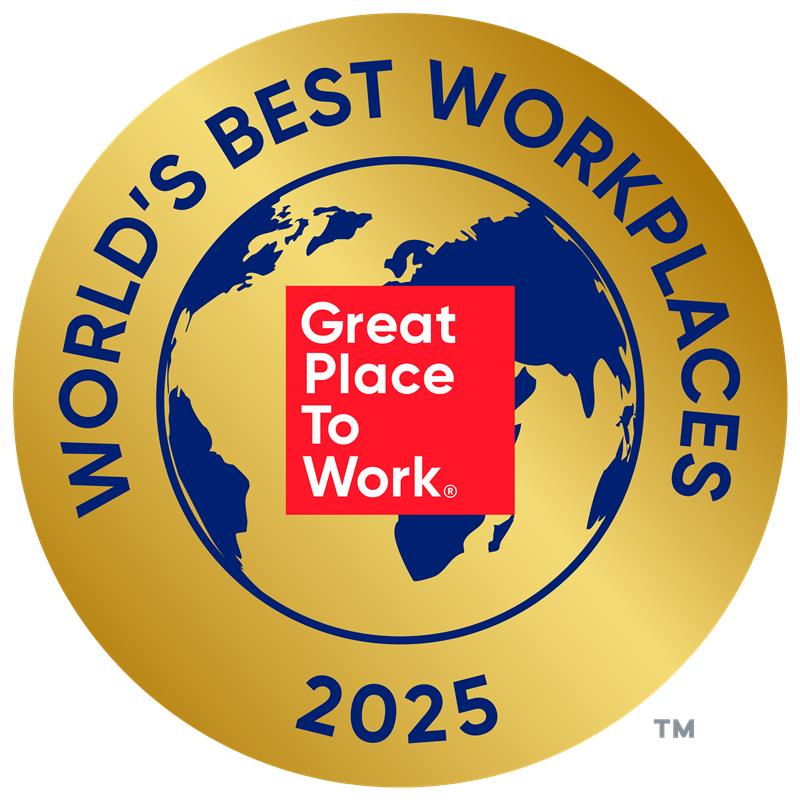
At Experian, we often say our people are our biggest superpower – and today, I’m thrilled to share that this belief has been recognised once again. Experian has been named one of the 2025 World’s Best Workplaces™ by Fortune and Great Place to Work® for the second year in a row.
This achievement reflects the culture we’ve built together – one that’s welcoming, inclusive, and rooted belonging. It’s a celebration of every colleague who brings their whole self to work, who lifts others up, and who powers opportunities for our clients, consumers, and communities.

We’ve made it our mission to create a workplace where everyone feels included, respected, and empowered. That’s why we’re proud to have earned top scores on the Corporate Equality Index and the Disability Equality Index, and to be recognised with the Outie Award for Workplace Excellence and Belonging.
These recognitions matter. But what matters most is how our people experience life at Experian. Whether it’s collaborating, innovating, or growing through world-class development of products, services and contributing to our communities, our culture is designed to help everyone thrive.
We’ve also made bold commitments to career development. Initiatives like Global Careers Week, the AI-driven performance coach Nadia, and the NextGen Forum – a global leadership development programme for emerging talent from across our regions – give our people the resources to take charge of their growth and build a “One Experian” mindset.
Being named one of the World’s Best Workplaces is a moment to celebrate but also a reminder to keep aiming higher. The world of work is evolving fast, and so are we. From embracing AI to enhancing our digital workplace experience, we’ll continue to push forward and listen to our people every step of the way.
Questions we will discuss:
- What does “retirement readiness” mean to you, and how can someone tell when they are financially ready to retire?
- Is there a magic number for retirement savings, and what factors should someone consider when setting a retirement goal?
- How can someone estimate their retirement expenses realistically?
- What are some common myths or misconceptions about how much money you need to retire?
- How should Gen Z, Millennials, and Gen Xers each approach retirement planning differently based on their stage of life?
- What are the biggest obstacles people face when trying to save for retirement, and how can they overcome them?
- How can you balance saving for retirement with paying off debt or supporting family today?
- What tools, calculators, or strategies can help people figure out if they’re on track for retirement?
- How can people prepare for unexpected costs or life changes that could impact their retirement plans?
- What’s one piece of advice you’d give someone just starting—or restarting—their retirement savings journey?
| Columns 1 | Column 2 | Column 3 | Column 4 |
|---|---|---|---|
| Row 1 Col 1 | |||
| Row 2 Col 1 | |||
| Row 3 Col 1 | |||
| Footer 1 | Footer 2 | Footer 3 | Footer 4 |

Credit Chat
Stretching your Dollars: Practical Tips to Cut Costs and Save More
February 5, 2025 3-4 PM ET
- What does “retirement readiness” mean to you, and how can someone tell when they are financially ready to retire?
- Is there a magic number for retirement savings, and what factors should someone consider when setting a retirement goal?
- How can someone estimate their retirement expenses realistically?

Greater transparency in buy now, pay later activity is key to helping consumers build their credit histories and supporting responsible lending. We have members of the military right now right out of high school and there’s not a lot of experience managing their own money. They’re quickly thrust into a place where they don’t have a support system to do that. We have members of the military right now right out of high school and there’s not a lot of experience managing their own money. They’re quickly thrust into a place where they don’t have a support system to do that. We have members of the military right now right out of high school and there’s not a lot of experience managing their own money. They’re quickly thrust into a place where they don’t have a support system to do that. We have members of the military right now right out of high school and there’s not a lot of experience managing their own money. They’re quickly thrust into a place where they don’t have a support system to do that. We have members of the military right now right out of high school and there’s not a lot of experience managing their own money. They’re quickly thrust into a place where they don’t have a support system to do that.
Experian North AmericaScott Brown, Group President, Financial Services

Lending activity is quickening, yet the overall debt burden remains high. Unemployment remains high nationally, though consumer spending is steadily increasing. Housing remains a stumbling block for the economy, while loan delinquencies show signs of improvement for most lines of business. What does this all mean? Our overall economy is recovering. While it’s no boom, it’s still a financial and emotional roller coaster, but with little gloom and no doom. Read our analysis of Consumer Credit Trends, released today at Vision 2012. A few highlights: Economic indicators are improving – The nation’s economic rebound from the Great Recession is real. While conditions haven’t quite returned to pre-downturn levels, the rate of recovery, which first emerged in June 2009, accelerated at the end of 2011 and that improvement is continuing strongly today. Consumers continue to manage significant debt obligations – On the debt front, overall burdens still remain high for many consumers despite further declines in outstanding loan balances at the end of 2011. In fact, total outstanding consumer debt has fallen more than $1 trillion since its peak in 2008. Lending activity is quickening – New lending has picked up, although 2011 brought a mixed story for that indicator. Bankcard originations and especially automotive loans were the biggest positives, as consumer confidence began to recover in response to improving economic factors. However, new mortgage lending remained weak. Delinquencies continue to trend lower – Loan delinquencies continue to show signs of improvement for most lines of business. Tighter lending standards and a change in payment hierarchy have sparked substantial improvements in the performance of newer originations in auto and bankcard loans. Housing will continue to struggle through 2012 – Housing remains a major stumbling block for the economy, and it promises to be some time before the housing market produces a real rebound from the 2008 bust. Mortgage-lending volumes remain at extremely low levels, despite record low interest rates. Further economic gains are anticipated – Most economists anticipate further improvement in key business barometers over the next few years. They foresee inflation-adjusted gross domestic product for the United States rising this year and in the next two by a moderate amount, with consumer spending also increasing. The Bottom Line: The nation’s economic recovery shows signs of real momentum. While it may be slow, it will be steady. Consumers continue to exhibit signs of increased confidence, and this is helping to bring discretionary spending back online. For lenders, 2012 is the year for them to return to pre-recession strategies if they are to grow significantly. They should concentrate on specific markets and portfolios. They must mitigate vanilla offerings of credit with market share gains.

Mortgage industry trends have already been a huge topic of discussion at Vision 2012. Although we’re seeing signs of recovery in the auto and bankcard lending sectors, we're clearly not out of the woods yet for the mortgage industry. On average, the S&P/Case Schiller index reports that home prices have declined four percent YOY, and they are expected to decline in many major markets as foreclosure activity picks up in the second half of this year. As long as mortgage delinquencies occur, the economy will lag, too. There’s another thing weighing down the mortgage industry. The credit tightening experienced in the mortgage market since 2006 is likely to continue, especially given the stringent criteria proposed by the Dodd-Frank Act for a “qualified mortgage.” This new criteria has increasingly stringent requirements for creditworthiness, loan size and debt-to-income ratios. Using the qualified mortgage criteria, we analyzed mortgages for the past six years and found that in 2006, nearly 1 in every 2 loans would not have met this criteria. This percentage steadily declined until 2009 when less than 1 in 3 loans would not have qualified. Believe it or not, since the onset of the credit crisis, the quality of the loans and borrowers has actually improved – by 2011, the quality of mortgage originations improved to the point that only 27 percent do not meet the qualified mortgage criteria. We attribute this decline to the increasingly stringent requirements imposed on borrowers to establish their creditworthiness and their ability to pay their mortgage. Especially as we see the economy improving in other areas (the average monthly debt-to-income ratio has been declining steadily – from 19 percent in 2011 down from 27 percent in 2006), hopefully this coupled with this mortgage data is a good sign. There’s no question that we’re not out of the woods yet, but these positive signs in consumer creditworthiness are cause for optimism. Recommended Reading Experian Addresses State of U.S. Credit Markets and More in New White Papers Getting Ready for Vision 2012 [Video] Photo: Shutterstock

Here is a list of 8 free white papers from our Experian Vision 2012 conference: State of the U.S. Credit Markets – At Last, Signs of a Real Recovery The economy’s recovery from the Great Recession may have started slowly, but it is accelerating – and it’s genuine. Economic indicators tell the story of improving business prospects. For credit issuers, the message is real, too. Now’s the time to look with fresh eyes at your post recession lending strategies. Download this free white paper. Universe Expansion – Growth Strategies in the Evolving Consumer Market As the economy gains strength, lenders are engaging in an increasingly fierce competition to entice the best candidates to their portfolios and to grow their lending business. A variety of prospecting strategies are now available that compliment and expand on a lender’s current growth initiatives – now is the time to ensure that optimal strategies are in place and that opportunities within near-prime are not overlooked. Download this free white paper. Converting Information to Intelligence – Current Trends in Mitigating Small-Business Risks Through Analytics As former Chrysler CEO Lee Iacocca put it, “Even a correct decision is wrong when taken too late.” Portfolio managers who oversee small-business risks know this well. They realize it when they make a decision about approving or rejecting a loan request and recognize later the correct decision would have been clearer if they could have weighed additional data and used improved analytics. This white paper presents some of these latest trends affecting the small-business lending landscape. Specifically, it illuminates how companies are using the new robust data sources and analytic tools – from consortium data to rapid model customization – to maximize their interactions with small-business clients with greater accuracy. Download this free white paper. Understanding Automotive Loan Charge-off Patterns Can Help Mitigate Lender Risk Loan delinquency rates are one of the most important statistics to track in the automotive finance industry. If consumers are not repaying loans on time, it puts billions of dollars at risk. Experian Automotive has found several clear patterns that can help lenders better understand the root cause of loan delinquencies. These can be found in vehicle buyers themselves through credit scores and length of credit history; through the vehicles themselves and their own history; and through the loans themselves by understanding the impact of high loan-to-value ratios. All of these data points provide insight into patterns of where charge offs are most likely to occur and can significantly impact the strategies lenders adopt. Turning the Tide – Managing Troubled Portfolios The economy may be recovering and the credit picture improving, but lending institutions still find themselves coping with some troubled portfolios. Plus, they always need to be prepared to identify high-risk accounts. What they can discover is that turning around a challenged loan portfolio requires taking just a few basic steps. Download this free white paper. Driving Profitability and Minimizing Risk Through Portfolio Management As the economy recovers, managers of small-business portfolios must always remember that their loan portfolios are constantly changing. That’s why it’s critical for risk managers to look at their debt holders differently. They must examine more closely the behaviors of these owners, especially to predict the potential for fraudulent activity and what can be done to minimize losses. This is vital because fraud committed by small-business owners, while relatively rare, generates at least three times the impact of a conventional fraud loss. Download this free white paper. Fraud Detection in Newly Opened Accounts — Connecting Data Helps Predict Identity Theft Fraud continues to be a genuine problem and challenge. After a sharp and unexplained drop in identity thefts in 2010, fraud schemes climbed 12.6 percent in 2011, research by Javelin Strategy & Research shows. Fortunately, the latest technologies and a new Experian® weapon — Precise ID for Customer Management — offer the opportunity to improve fraud detection substantially, especially very early in the Customer Life Cycle. This paper explores how this new weapon helps detect identity theft and other fraud and how data velocity can prove the key to predicting identity theft. Download this free white paper. Overview of the Consumer Financial Protection Bureau — What’s New and What to Expect in 2012 The Consumer Financial Protection Bureau (CFPB) received authority to enforce a majority of the nation’s financial consumer protection laws in July 2011, but the new regulator’s powers were limited until President Obama made a “recess” appointment in January 2012 to name former Ohio Attorney General Richard Cordray as the first director of the CFPB. Now, the CFPB has the authority to not only enforce existing consumer protection laws but also to write new regulations for non-bank financial institutions and to supervise their activities. It is imperative that financial institutions under the authority of the CFPB ensure that they follow industry best practices and are in compliance with current federal and state regulations to prepare for future actions by the new consumer financial regulator. Download this free white paper.
2024 Best Place to Work for Disability Inclusion


